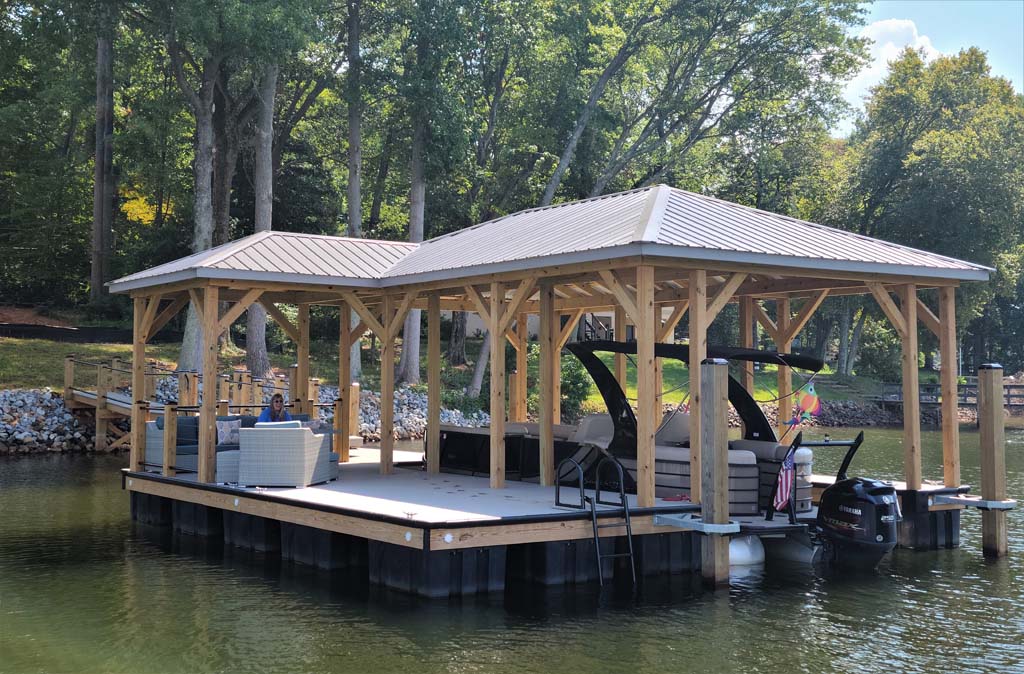Upgrade Your Waterside With Long Lasting Floating Docks
Upgrading your waterfront with durable floating docks can considerably enhance both capability and visual appeals, supplying a flexible solution for various water activities. These structures are designed to adapt to fluctuating water degrees, ensuring security and access throughout the periods. With a range of materials readily available, including low-maintenance choices and standard wood, selecting the right dock can enhance your personal style and fulfill sensible requirements. Nevertheless, comprehending the nuances of installation and maintenance is critical for making sure durability and efficiency. When making this financial investment?, what elements should you consider.
Advantages of Floating Docks
Floating docks offer a wide range of benefits that improve their charm for different maritime applications. Unlike conventional set docks, floating docks surge and fall with the tide, guaranteeing constant availability for boats and watercraft no matter of ecological conditions.
Furthermore, floating docks are easier to transfer and mount, giving adaptability for seasonal or momentary usage. Their modular layout permits for personalization to fit details demands, whether for personal marinas, property watersides, or business applications.
Additionally, floating docks produce very little disturbance to the aquatic environment, maintaining local communities and lowering the probability of erosion. They additionally offer enhanced security and stability for customers, as their buoyant nature supplies a much more flexible surface area than rigid structures.
Additionally, floating docks can assist in a varied variety of tasks, such as fishing, swimming, and entertainment boating, making them a useful asset for waterside development. Their adaptability and functionality make floating docks a recommended option for a selection of maritime projects.
Choosing the Right Products
Picking suitable materials for floating docks is vital to their long life, efficiency, and overall performance. When selecting materials, take into consideration aspects such as ecological exposure, upkeep needs, and architectural integrity. Usual materials include wood, plastic, aluminum, and composite alternatives, each offering distinct benefits and drawbacks.
Wood, while visually pleasing, requires normal maintenance to avoid rot and degeneration. Pressure-treated wood can enhance toughness, yet it may still catch water damages gradually. Plastic floats, usually made from high-density polyethylene, are resistant to corrosion and need very little upkeep, making them an eye-catching option for low-maintenance applications.
Aluminum is one more feasible choice, known for its toughness and lightweight homes. It is resistant to corrosion and can stand up to extreme climate condition, although it may be extra expensive than other products. Compound products combine the very best characteristics of timber and plastic, offering a low-maintenance and resistant option that mimics the appearance of timber without the connected downsides.
Ultimately, the choice of product must straighten with the planned usage, ecological considerations, and budget restraints, making sure a durable and functional floating dock that satisfies your specific needs.
Installation Process Introduction
The effective setup of a drifting dock depends on careful preparation and additional resources implementation, guaranteeing that it runs effectively in its desired setting. The initial step entails evaluating website conditions, including water deepness, coastline attributes, and dominating climate patterns, which will inform the dock layout and anchoring system.
Following the site assessment, the next phase is to prepare the floating dock components. This includes putting together the framework, protecting floats, and attaching any necessary equipment. It is critical to make sure that all links are waterproof and robust to stand up to marine problems.
As soon as the dock is constructed, the installment process begins with placing the dock in the water. This can involve a crane or other lifting equipment, especially for bigger frameworks. Proper placement is important for performance and safety and security.

Upkeep Tips for Durability
Routine upkeep is essential for guaranteeing the long life and optimal efficiency of a floating dock. To attain this, begin with routine evaluations at the very least twice a year, focusing on the integrity of the dock's structure, consisting of the flotation gadgets and connecting equipment. Search for signs of rust, wear, or damage, and address any type of problems immediately to prevent more damage.
Cleaning up is one more vital element of maintenance. Get rid of debris, algae, and barnacles from the dock's surface to protect against unsafe problems and keep aesthetic allure. Utilize a soft brush and a moderate detergent to avoid damaging the dock's products.
In addition, guarantee that the dock is correctly secured and secured to hold up against seasonal changes in water degrees and climate condition. Check the anchoring system for stability and make modifications as essential.
Enhancing Your Outdoor Visual
To produce an aesthetically attractive exterior space, incorporating a drifting dock can substantially boost the general visual of your waterside property. this Floating docks are not just useful however can additionally act as a striking centerpiece that enhances the natural environments - floating dock company. Available in numerous products and styles, these docks can be personalized to match your property's architectural style and landscape
The addition of ornamental elements, such as integrated lighting or elegant barriers, further raises the dock's aesthetic appeal. Think about using all-natural wood finishes, which blend seamlessly with the setting, or selecting contemporary materials like light weight aluminum or composite decking that provide a smooth, contemporary look.
Purposefully placing planters or seating areas on or around the dock can develop inviting spaces that motivate relaxation and enjoyment of waterfront sights. In addition, including shades and structures that balance with your landscape will certainly develop a cohesive visual throughout your outside location.

Verdict

Upgrading your waterside with sturdy floating docks can considerably improve both functionality and appearances, providing a versatile remedy for various water activities. Unlike typical fixed docks, floating docks surge and autumn with the trend, making sure regular accessibility for watercrafts and watercraft regardless of ecological problems.Selecting ideal products for floating docks is vital to their long life, efficiency, and general efficiency.Once the dock is set up, the installment procedure commences with positioning the dock in the water.In summary, floating docks offer countless benefits, including versatility to water degree adjustments and a variety of material alternatives.